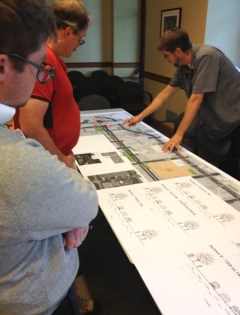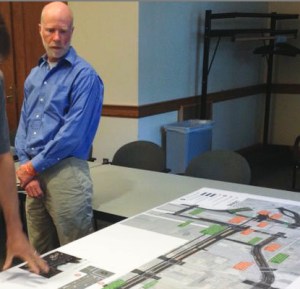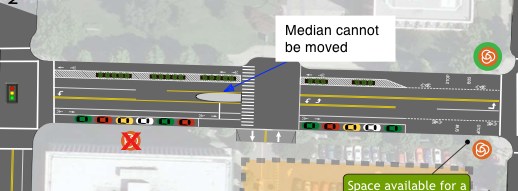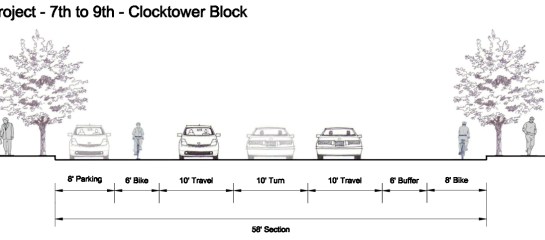
explains the plans to BAC members.
(Photos © J. Maus/BikePortland
The Portland Bureau of Transportation (PBOT) is trying to broker a compromise between real estate owners and developers in the Lloyd District and concerned citizens who want high-quality bicycle access on NE Multnomah Street. When staffers brought the latest plans for the Multnomah Street (NE) Main Street Pilot Project to the monthly meeting of the PBOT Bicycle Advisory Committee last night, several committee members expressed skepticism and objections to the philosophical underpinnings of the project, saying that PBOT was giving away too much in terms of bike access in order to meet the Lloyd TMA’s demands for auto parking.
At issue is how to allocate roadway space on NE Multnomah. PBOT is looking to transform it from a boring, 1980s-style, five-lane thoroughfare with no auto parking (and rarely used four-foot bike lanes), to a more vibrant and welcoming three-lane cross-section with protected bikeways and dozens of new, on-street auto parking spaces. (More background on the project here.) The street is already slated for a new 900-unit residential tower and other developments are expected in the future.
“We need a commercial corridor that shows you can put bikes at a higher priority than parking.”
— Ian Stude, BAC member
At the initial open house back in May, PBOT received considerable negative feedback from people who ride bicycles in the Lloyd District due to the combination of over 70 new on-street car parking spaces and an unimpressive bikeway treatment. Since then, PBOT has refined their design in an attempt to balance the demands of all stakeholders.
However, even with significant changes to the design, the discussion at the BAC last night was tense. BAC members expressed discomfort with several aspects of the project, from the proposed width of the bikeways, to the amount of on-street auto parking (and the complete lack of on-street bike parking). PBOT’s head of Transportation Systems Management (formerly City Traffic Engineer) Rob Burchfield and PBOT project manager Ross Swanson presented two versions of the plans — the “Pilot Project” they’d like to begin implementing this summer (PDF), and the “Possible Future Evolution” plan (PDF) that was put together by request of the Lloyd TMA to demonstrate the maximum number of parking spaces (I counted 94) that could be added if necessary in the future.
The plans sparked a debate about how PBOT balances the demands of stakeholders and what should have priority in a developing commercial district — on-street car parking, or high-quality bike access. It also provided bike advocates with a dilemma: Is it better to hold out and/or press for the highest-quality bike access possible, or accept an incremental improvement now and hope for enhancements in the future?
The Lloyd TMA (which is funded by Lloyd District business owners and real estate developers) sees parking as crucial to “activating” the street (planner-speak for making it more vibrant); but the eight feet required for a parking lane constrains the bikeway options (no to mention the other 29 feet for the two lanes and a center turn lane). PBOT has been put in the position of defending the parking, seeing it as a bargaining chip in order to get the Lloyd TMA’s endorsement of the project. (Note: The TMA is funding about half of the project’s $200,000 price tag.)
“It’s a little hard to imagine ‘world-class’ on a third-world budget. That’s the reality of where we’re at.”
— Rob Burchfield, PBOT
At the outset of the discussion, PBOT announced that the road is actually two feet narrower than they originally thought: 58 instead of 60 feet. A narrower road width, combined with the perceived need to maintain add auto parking and a desire to create a parking-protected bikeway, has led Burchfield to propose a narrower bike lane.
Instead of the seven-foot wide standard bike lanes (with cars parked against the curb) shown at the May open house, PBOT is now proposing a 5-foot bike lane and 3-foot buffer protected from moving traffic by parked cars. This new layout is seen by PBOT as the only way to provide a protected bikeway and still maintain auto parking.
BAC members expressed concerns that a five foot bike lane wouldn’t be adequate for future bike capacity. BAC member Ian Stude (who manages Transportation Options at Portland State University) pointed out that, “Every bike facility we’ve built today is not wide enough for the future. Where is future capacity for cycling in this?” Stude added that anything that narrows bikeway capacity will end up in the same situation we’re in with the Hawthorne Bridge and N. Williams, “Where it feels too narrow.”
BAC Chair Matt Arnold (an urban planner at SERA Architects) sees Multnomah as a perfect place for Portland to (finally) build a world-class bikeway through a commercial corridor. “We don’t have too many opportunities to look at this type of area, with a big bike connection that gets you from neighborhoods, to a bridge and then into downtown… This is the one place where you can do something very cool.”
Burchfield urged for the compromise. He said he recently rode new protected bikeways in Chicago with the 5/3 dimensions and said they worked “fine”. “I wasn’t promoting this until I rode it in Chicago with [PBOT Director Tom Miller] and we thought, ‘This totally works, why can’t we make this work here?'”
As a comparison, the existing parking-protected bikeway (a.k.a. cycle track) on SW Broadway near PSU is seven feet wide. The one on NE 7th through the Lloyd District is six feet wide. “Ride NE 7th and think about… If that bike space was one foot narrower, how would that space work for you?” Burchfield asked the BAC.

He then explained how coming to terms with a five foot bike lane was essential, not only to making this project work, but perhaps in building future parking protected bike lanes throughout the city.
“Basically, if we want to have a parking protected facility as opposed to an outboard bike lane,” continued Burchfield, “we’ve got to be willing to understand the minimum dimensions that we can work with here and be comfortable with. By going to that dimension, we can provide more areas that have that parking buffer/protection.”
BAC members stood up for their concerns, and for bike access in general, and continued to press Burchfield.
In one exchange, Stude questioned the need for on-street auto parking in a certain section and Burchfield responded by saying the Lloyd TMA “wants some activation at the street level”. To that, Stude replied, “We’re just saying, that [activation] isn’t parking.” “I heard what you’re saying,” said Burchfield, “But they [the TMA] believe it is.”
Arnold also questioned whether parking was necessary between NE Grand and 9th. “Do we actually need to introduce parking here at all?” he asked. “The reality is,” Burchfield replied, “I don’t think we’ll get our stakeholders in the Lloyd District to agree to that.”
Arnold is a veteran of Portland bike advocacy and has been involved with PBOT projects for many years. He tried to strike a diplomatic tone with Burchfield, but it was clear that Arnold has become tired of PBOT compromising bikeway quality for business interests. “The Lloyd District is an area where we can make the connection for interested but concerned riders to ride through here in large numbers… Is this a place, where, for once, the city of Portland can put a stake in the ground?”
Also speaking to the opportunity this project represents, Stude added, “We need a commercial corridor that shows you can put bikes at a higher priority than parking.”
Heather McCarey (executive director of the Westside Transportation Alliance) expressed displeasure that the plans — despite showing 40-90 new auto parking spaces — still don’t show any on-street bike parking (a point that I and others raised back in May). “I want to see some on-street bike parking in the plan,” she said. Burchfield replied by saying, “We need to see demand for it.” McCarey, who used to work in the Lloyd District, assured him the demand was there.
McCarey then asked a question: “We have triggers to add on-street auto parking, is it possible to have triggers that would move toward a world class bike facility?”
The “triggers” McCarey mentioned are a set of metrics being discussed between PBOT and the Lloyd TMA stakeholders that if met, would obligate PBOT to add more on-street auto parking. The triggers could be occupancy rates of the new parking (it’ll all be metered, so PBOT will have good data), land-use changes, new developments, and so on.
Another big point of contention at the meeting was the section of Multnomah between NE 7th and 9th. Of all the segments, this is the worst one for bike access. In the eastbound direction, it’s proposed to have a standard, six-foot bike lane with no buffer against moving auto traffic. Here’s the plan drawing:

And the cross-section:

Burchfield says that because the median is not planned for removal in this project (not enough money), the design options are limited. He acknowledged that this is the worst section of bikeway in the project; but said the entire project shouldn’t be judged by this one “anomalous” block face.
Exasperated with the BAC’s objections — and trying to impress upon the group that this is an important, incremental improvement — at one point Burchfield said, “Does perfect need to be the enemy of the good?”
In his defense, Burchfield leveled with the BAC, saying, “It’s a little hard to imagine ‘world-class’ on a third-world budget. That’s the reality of where we’re at. If we were doing world-class here, I would want three-quarters of a million dollar budget to do it.”
A major part of the heartburn by the BAC is that PBOT showed one version of the plan with over 90 on-street auto parking spaces and an even less desirable bikeway. PBOT called that draft of the plan an “evolution”. “If you’re opposed to parking, that’s the worst-case scenario,” Burchfield acknowledged. PBOT project manager Ross Swanson said they drew up that plan to, “Reassure the interests in the Lloyd District that they can evolve their parking and we can live together with the bike community.”
Arnold tried to explain that the tension Burchfield was feeling from BAC members is due to the power the Lloyd TMA and their parking demands seem to be having over this project. “This plan was put together to assuage the concerns of the Lloyd TMA and the property owners they represent. We don’t see the alternative vision that shows the world-class facility for bikes.”
Arnold also expressed that this project on Multnomah was “dangled out by the Lloyd District” as an alternative to bike access improvements on NE Holladay. “We aspired for world-class bike conditions on Holladway. When we start to see less than world-class on Multnomah, it feels like we got baited and switched by the Lloyd District… And they end up getting a lot parking and we end up getting some striping… It doesn’t feel good.”
Advocate Carl Larson with the Bicycle Transportation Alliance then piled on, “It went from, ‘Holladay doesn’t work because parking can’t be removed’, to, ‘One lane of parking on Multnomah doesn’t work because we can’t add yet another lane of parking’.”
Again Burchfield tried to defend the project and the Lloyd TMA. “It’s a main street project, not a bike project,” he said, “So the people that own the property, that have the business, they need to be willing partners for the project to be successful.” Burchfield then continued:
“As bike advocates you can be loud for what you think is best for bikes, but ultimately what we’re trying to do is come up with a street that works well for everyone that has a stake in it. We’re trying to strike a good and reasonable balance… Personally, I think this is a big step fwd over what we have today. To be able to get there with the resources we have, as opposed to saying ‘It’s not good enough, let’s go back to drawing board, let’s push for more and see what we can get,’ That’s a risk. You may get nothing. It’s strategy question.”
Arnold tried to explain to Burchfield that the frustration felt by the BAC comes from years of having bike facilities in these larger projects done “on a shoestring budget.” “We’ve got this 2030 bike plan, we tinker in the neighborhood streets; but when it comes to really doing cool stuff, we’re tired of doing it on the cheap in the big, dense commercial areas.”
Burchfield expressed that he feels he’s getting beat up from both sides. “It’s not about one party getting everything they want, it’s about finding the right balance.” He said the BAC should look for win-wins and try to “get something that’s good for cyclists and also that works well for the business environment.” “If we can find those win-win solutions, we’re going to have more opportunity to get things done in the future. If we always fight a win-lose battle, well, some days you win and some days you lose.”
The BAC made no official decision as to whether endorse the project; but in general, PBOT seems firm on their current plans. “If this [general plan] isn’t good enough,” Burchfield said a few times, “If you can’t live with this, we’re done. We don’t have a project we can do this summer.”
Stay tuned.
— Read further coverage of this project here.
— Download the Pilot Project plans (PDF) and the Possible Future Evolution plans (PDF)
— Visit the official project website and email PBOT your comments and feedback here.

